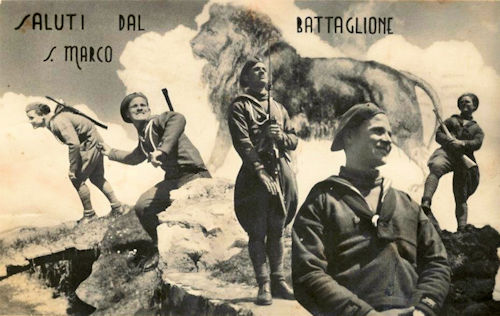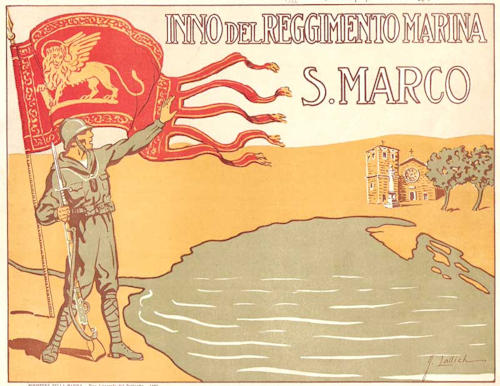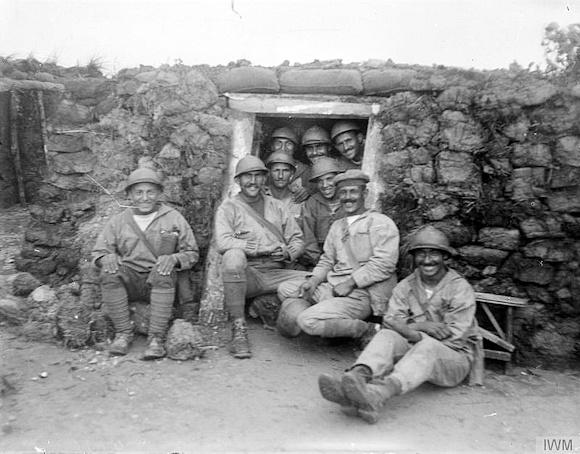Along the Adriatic coast, the Regia Marina had equipped armed trains with cannon disassembled from mining ships that raced from Ravenna to Brindisi. The command had also created armed pontoons and barges that operated in the lagoon of Venice, Caorle, Grado and along the riverside. Already after the declaration of war, the Pisa Division, then the IV Naval Division, consisting of units: Pisa, Amalfi, San Giorgio e Saint Mark, she had arrived in Venice. The 20 July with the surviving crew of the cruiser Amalfi the first terrestrial lagoon battery was created by 76 / 17 operating with the Perugia Brigade, 129 ° and 130 ° infantry, on the sea side of the 3rd army. 97 artillery pieces of various caliber which were in the VII ° C, a real regiment, were in action in the fall.
With the retreat of Caporetto all the equipment and logistics of coastal and river navigation as well as terrestrial artillery departments had to be moved. The 28 October was unveiled Monfalcone and the 29 Grado. The November 3 had to leave the Tagliamento and go back to the Lagoon, where - between the Sile (Piave vecchia) and Piave - a humid contrast zone was created. This barrage stretched for about 40 kilometers from San Donà to Cortellazzo. The 9 November was rebuilt by the "Pool Artillery Regia Marina", commissioned by Frigate Captain Antonio Foschin, a few days later the Regia Marina Naval Inspectorate was set up in Venice. The latter was intended to gather all available forces and coordinate the establishment and launch of organic departments at the front. In the capital city of Veneto, the staff of Grado and Monfalcone had been concentrated, which had gone to add to the one already existing and to the other in turnout from different bases. In view of the fact that from the prewar period the various Maritime Commanders had begun training for Coast Guard Coastal Defense departments, it was therefore possible to establish relatively short sea battalions for combat on the land front. The first one, named "Monfalcone", was formed by personnel belonging to the defenses of Grado and Monfalcone. It was composed of a total of 22 officers and 899 men, framed in four companies, then reduced to three. For two others, "Caorle and Grado", the staff was attracted by the coastal defense companies of La Spezia, Naples and Messina.
 By the end of 1917 a fourth battalion was also formed, called "Navi", as it is formed with personnel coming from various naval units; initially dedicated to the defense of Ancona, the battalion was then released from that task and reached other battalions in line with the name "Golametto". All of these branches were framed within the Marina Regiment, which was placed under the command of Captain Alfredo Dentice of Frasso (1873-1940). A fifth battalion was instead devoted to complementary training functions. The Navy Regiment and the Artillery Regiment were part of the Marina Brigade, whose command was in Venice. The first battalion to be used on the front was Monfalcone, which November 15 rejected an enemy attack. The 3 December was reached by Caorle, while the whole regiment became distinct on the 19 day, succeeding in containing a violent attack brought by Austro-Hungarians, intent on reaching Venice by Christmas. Months followed by a wretched patrolling activity, featuring ecclesiastical "regimental hustle and bustle", made up of spontaneous and voluntary initiative within the individual departments. Venice, already saved thanks to the desperate resistance of November-December 1917, wanted to offer to the Regiment that its most distinctive defense was the Battle Banner, which was solemnly delivered to St. Mark's Square on 19 May 1918.
By the end of 1917 a fourth battalion was also formed, called "Navi", as it is formed with personnel coming from various naval units; initially dedicated to the defense of Ancona, the battalion was then released from that task and reached other battalions in line with the name "Golametto". All of these branches were framed within the Marina Regiment, which was placed under the command of Captain Alfredo Dentice of Frasso (1873-1940). A fifth battalion was instead devoted to complementary training functions. The Navy Regiment and the Artillery Regiment were part of the Marina Brigade, whose command was in Venice. The first battalion to be used on the front was Monfalcone, which November 15 rejected an enemy attack. The 3 December was reached by Caorle, while the whole regiment became distinct on the 19 day, succeeding in containing a violent attack brought by Austro-Hungarians, intent on reaching Venice by Christmas. Months followed by a wretched patrolling activity, featuring ecclesiastical "regimental hustle and bustle", made up of spontaneous and voluntary initiative within the individual departments. Venice, already saved thanks to the desperate resistance of November-December 1917, wanted to offer to the Regiment that its most distinctive defense was the Battle Banner, which was solemnly delivered to St. Mark's Square on 19 May 1918.
The 1918 summer saw a regiment of the Regiment, which always consisted of four Battalions, the "Monfalcone" had been renamed "Bafile" in the meantime, by the name of the lord of the vessel Andrea Bafile (1878-1918), first decorated with Medal Gold to the Military Regiment of the Regiment. Each Battalion consisted of three rifle companies, one of the machine gunners and a seizure unit. There was also the official presence of a daring regimental department, as well as of a lagoon machine gun company, which had vessels with flat bottom. With this force, the Regiment Marina took part in the latest phases of the conflict, directly participating in the liberation of Italian lands beyond the Adriatic. The "Golametto", boarding in Venice, landed in the afternoon of November 3 in Trieste, while on Day 10 the "Bafile" reached Duino and Nebresina and the "Caorle" Pula. The only exception, the "Grado", which moved to Taranto and embarked, reached Valona. In Pula, the "Caorle" and the "Bafile", together with the Regiment Command, they took accommodation in the barracks "Franz Josef", the seat of the Austro-Hungarian Navy School, which later took the name of "Nazario Sauro" and would become the permanent seat of the Regiment. In the turbulent days that followed, other Adriatic lands required the presence of sailors: in early December the "Bafile" was transferred to Rijeka, "Caorle" in Veglia, Lussino and Arbe, while "Grado" sent its detachments to the islands of Curzola and Lesina. Only the Golametto remained in Pula.
 In January the Regiment was once again reunited in the Istrian town to start demobilizing the older classes. On 17 March 1919, the King granted, upon the request of the mayor of Venice, endorsed by the Minister of the Navy, his authorization for the Marina Regiment to be named "San Marco". And on March 25, just in St. Mark's Square, with an official ceremony and with the blessing of the Patriarch of the city, the winged lion, gold in red field, seen in profile, appeared on the showcases of officers and non-commissioners, so such as the knobs applied to the contours of the subcapacity and common sleeves. And since then the symbol of the Serenissima has continued to be the emblem of the Regiment, an indissoluble combination born in the trenches of the lower Piave and destined to perpetuate over time.
In January the Regiment was once again reunited in the Istrian town to start demobilizing the older classes. On 17 March 1919, the King granted, upon the request of the mayor of Venice, endorsed by the Minister of the Navy, his authorization for the Marina Regiment to be named "San Marco". And on March 25, just in St. Mark's Square, with an official ceremony and with the blessing of the Patriarch of the city, the winged lion, gold in red field, seen in profile, appeared on the showcases of officers and non-commissioners, so such as the knobs applied to the contours of the subcapacity and common sleeves. And since then the symbol of the Serenissima has continued to be the emblem of the Regiment, an indissoluble combination born in the trenches of the lower Piave and destined to perpetuate over time.
The Navy Regiment was awarded the silver medal for the military value with the following motivation: "He arrested the advanced enemy in Cortellazzo, and established himself on a bridgehead that held firmly for eight months, extending it with daring actions aimed at wearing down the resistance of the adversary; he concurred with shining valor and generous blood sacrifices to the further operations for the liberation of the Fatherland ". (delta del Piave, December 1917-July 1918)













